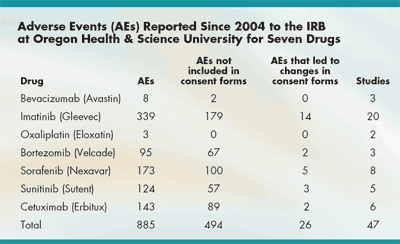Reporting Only ‘Unanticipated’ AEs of Trial Drugs Would Reduce IRB Workload, But Would Patient Safety Suffer?
Enrollment in clinical trials is crucialto continued scientific discovery andimproved patient care.
Enrollment in clinical trials is crucialto continued scientific discovery andimproved patient care. However, publictrust in clinical trials has diminished inrecent years due to a few well-publicizeddeaths and serious adverse events (AEs)that occurred in phase I/II trials. Minimizingrisks of serious injury and deathduring clinical research may increase thewillingness of patient-subjects to participatein clinical trials. This is particularlyrelevant since adverse drug reactions accountfor more than 100,000 patientdeaths per year in hospitals in the UnitedStates.[1]
While clinical trials identify benefitsand common side effects of drugs, theirpractical size limits the likelihood of detectingall but the most common AEsprior to drug approval. Similarly, clinicaltrials limit the profile of patients who testnew drugs. As a result, more than half ofall new drugs have serious undetectedtoxicities at the time of their initial FDAapproval.[2]
FDA outside of the clinical trial setting islow, and these reports are often of poorquality. Failure to detect occurrences ofserious AEs with novel cancer agents inthe clinical trial setting may result in continueduse of these agents in ongoing andfuture clinical trials without the necessaryinsight about the true toxicity profile,and subsequent clinical trial participantscan be injured or die from thesetoxicities.
With improved pharmaco-vigilancepractices, it may be possible to improvethe detection of serious AEs during clinicaltrials--before the drug is approvedand widely available.
Role of IRBs
One means of improving AE detectionis through improved InstitutionalReview Board (IRB) mechanisms. IRBoversight of medication safety is an especiallyimportant issue in oncology clinicaltrials due to the expected toxicity ofcancer drugs, the large number of cancerpatients who participate in clinical trials,the high frequency of comorbidity, thedifficulty in distinguishing drug toxicityfrom underlying disease in cancer patients,and the importance of clinical trialsin both clarifying the optimal uses ofnovel cancer agents and improving post-marketing assessments of safety.
Physician investigators routinely reportinformation on serious AEs throughreports to IRBs, Data Safety MonitoringBoards (if applicable), and pharmaceuticalsponsors, who submit required safetyreports to the FDA. In fact, one of themost important ways the IRB safeguardsclinical trial participants is by ensuringthere is an adequate data and safety monitoringplan related to a study.
Flood of Reported AEs
In the 1990s, drug companies extendedthe regulatory requirements issued by thegovernment and began to require that allserious AEs of a drug under investigationbe reported to the investigators' local IRB,including reports from other study sitesand from other studies with the investigationaldrug. This led to a flood of paperworkand adverse event reports--many of them overlapping--that haveoverwhelmed chronically underfundedIRBs.[3] For example, one large centerreported receiving more than 10,000 reportsper year with only one primary personavailable to read and interpret thereports.
It is also widely thought that shortagesof clinical pharmacology and disease expertsand resources impede IRBs fromefficiently evaluating reports of seriousAEs.[3] Further adding to the ambiguity,there is no standard definition of AEsacross government and nongovernmententities.
This inundation of adverse event reportshas resulted in a large amount of"noise" relative to "signal" in the areaof pharmaco-vigilance and has overwhelmedthe limited resources availableto local IRBs. With more than 3,000 IRBsin the United States, this poses a threat tothe safety of cancer patients participatingin clinical trials and subsequently to allpatients with cancer.
New Guidance
A recent federal draft guidance hasrecommended that federal regulations beamended to require that investigators notifyIRBs of AEs only when there are "unanticipatedproblems involving risks tosubjects," as distinct from the InvestigationalNew Drug (IND) application regulation,which requires that all adversedrug or device events be reported. Consequently,many IRBs are now adoptingthe recommendations in the guidanceand moving to require that investigatorsreport only unanticipated adverse eventsto the IRB.
While the definition of unanticipatedevents or unexpected events (terms usedinterchangeably) varies, an operationaldefinition accepted by most IRBs is thatan unanticipated AE refers to any AE thatis not included in the patient consentforms.
This operational definition has the advantageof relative simplicity but the disadvantageof potentially missing knownevents that are more severe or knownevents that are more frequent than indicatedin the informed consent document.
Potential Impact
It is not known how institution of thisnew policy, whereby IRBs would be notified only of AEs not mentioned in thecurrent informed consent forms, wouldaffect the workload of the IRB and patientsafety.
To assess the potential impact of thenew policies, we reviewed AEs reportedsince 2004 to the IRB at Oregon Health& Science University for seven drugs (seeTable).

There were 885 unique AEs reportedfor these drugs. Of these AEs, 494 wereunanticipated, meaning the event was notdescribed in the consent form for thestudy. Twenty-six AEs led to consentform changes, suggesting that these signalevents represented serious but previouslyunknown toxicities of the studydrug. Thus, at this institution, the IRBworkload would decrease by 44% underthe new guidance. At the same time, thesignal-to-noise ratio would improve from3% to 5%.
While IRBs are hopeful that the changingpolicies will make it easier to identifyunanticipated, serious side effects, moreempirical evidence is needed to ensurethat this new guidance does not harmpatient safety.
Ms. Angelotta is a project coordinator in Dr. Bennett'soffice. Dr. Dorr is assistant professor of medicalinformatics and clinical epidemiology, Oregon Health& Science University. Dr. Bennett is professor of medicine,Division of Hematology/Oncology, NorthwesternUniversity Feinberg School of Medicine; co-leader,Cancer Control Program, Robert H. LurieComprehensive Cancer Center of Northwestern University;and associate director, Midwest Center forHealth Services & Policy Research, Jesse Brown VAMedical Center-Lakeside CBOC.
References:
1. Lazarou J, Pomeranz BH, Corey PN: Incidenceof adverse drug reactions in hospitalizedpatients: A meta-analysis of prospective studies.JAMA 279:1200-1205, 1998.
2. Lasser KE, Allen PD, Woolhandler SJ, etal: Timing of new black box warnings and withdrawalsfor prescription medications. JAMA287:2215-2220, 2002.
3. Emanuel EJ, Wood A, Fleischman A, et al:Oversight of human participant’s research: Identifyingproblems to evaluate reform proposals.Ann Intern Med 141:282-291, 2004.